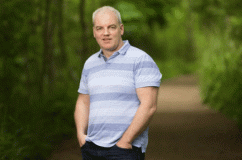Can virtual reality nature help students with exam anxiety?
ToggleTwo Irish studies have explored whether experiencing nature through virtual reality can help alleviate test anxiety, write Dr Tadhg MacIntyre of MU's Department of Psychology and Dr Annalisa Setti of the School of Applied Psychology in UCC.
Virtual reality can make us 'be somewhere else', for example a greener place, to help us feel better here and now, and can also help us plan for a better future. But how?
It was the start of exam week and James was anxious. Like many students, he struggled with test anxiety. The weather was not helping, and it was hard to get the motivation to go out for a walk. Then, his friend suggested something different: a virtual walk through the woods.
Curious, James slipped on a pair of VR glasses and suddenly found himself standing in the middle of a forest. For a few minutes, he was in a different, calming place, not in the exam hall about to take a test. Once ‘back’ in the hall, he felt refreshed and more positive. Could this fictional scenario become reality at some point?
James isn’t alone. Many students today face great pressure, leading to increased levels of test anxiety. Researchers have been on a mission to find innovative solutions, and virtual reality is emerging as a surprising new tool. In two studies from University College Cork we have explored whether virtual nature can alleviate test-related stress when accessing real nature is not possible.
In the first study, published in Multimodal Technologies and Interaction, university students were divided into two groups. One group experienced a virtual green space (a 360 video of Coombaune Woods in Kenmare, Co Kerry) while the other explored virtual urban environments. Both groups were tested on their emotions before and after their VR experience. Students with higher test anxiety who explored the virtual nature scenes reported a significant reduction in negative feelings. The calming effects of nature—well documented in real life—seemed to extend into the virtual world.
In a follow-up study, published in Virtual Reality, students used the same videos in their own homes, using their phone and inexpensive, phone-based VR goggles. Even the brief exposure—just four minutes—was enough to bring some emotional relief. Though there were technical glitches, like dizziness from lower-end VR goggles, virtual nature could enhance positive emotions. The actual performance in the tests, in these studies, was relatively good no matter what video was shown, but those who had higher anxiety and could avail of virtual nature found the test experience more pleasant and less stressful.
For students with test anxiety, the emotional relief was valuable on its own, but it didn’t magically lead to better grades. However, feeling more relaxed and less anxious is a significant victory for those battling test anxiety. After all, the emotional toll of anxiety can be just as draining as the exam itself.
One interesting aspect of the follow-up study was the technology used—basic, phone-based VR goggles. While they didn’t offer the same immersive experience as high-end VR systems, they were accessible and affordable, meaning that this kind of well-being support could be available to more students.
Another example of a virtual natural laboratory is the role in developing future scenarios to support transformative change in cities. In the GoGreen Next Horizon Europe project led by Maynooth University, prior research by the team led by Sigbjorn Litleskare (University of Inlande, Norway) has suggested that virtual nature has the potential to change citizens' perceptions and relationship with nature.
As part of current research in the GoGreen Next project, we are developing a range of future scenarios based on different impacts of climate change and climate mitigation strategies, such as regreening cities. The project uses high fidelity virtual reality systems, with the HTC ViveTM system, to create a ‘walk-in-place’ method with the urban landscape sourced from Open Street Map.
Working with Cork city and three other pilot areas, we support decision-makers and key actors in city decision-making on different possible future scenarios. Participants will be able to add ‘green infrastructure’, such as parklets and green roofs, to digital streetscapes and experience the environment through walk-in-place VR. This will ensure their thinking of future scenarios is guided by experience, which can overcome cognitive biases by generating specific urban streetscapes that meet the challenges of climate change, biodiversity loss and physical inactivity.
The above studies on virtual nature offer a glimpse into what the future well-being could look like. As technology continues to evolve, more immersive and realistic VR experiences may further enhance the psychological benefits of virtual nature.
While VR isn’t a replacement for real-world experiences, it could offer a powerful tool for those who can’t access real nature or a motivator for those who do not spontaneously seek nature contact. Virtual nature has the potential to bring nature to us, to encourage us to establish a relation with it.

This piece originally appeared on RTÉ Brainstorm
